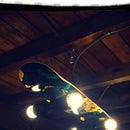Introduction: Vintage Coffee Machine Restoration
Here we have a 1979 La pavoni europiccola that I bought to restore. These are great machines for projects, and also make great coffee! Keep reading and find out how to do it yourself!
Supplies
La pavoni coffee machine (in need of restoration)
Hand tools
Dremel
Workbench of some kind
Paint stripper (adult assistance may be required)
Paint brush
Gloves
Cloths
Woodlathe and tools
Casting resin
Recycled skateboards
Resin pigment
Clear lacquer
Spare parts for coffee machine (as required)
Step 1: Let’s Begin...
Ok so once you have got your La pav that needs work, you need to try and identify what work it needs. The machine I picked up was 40 years old so it needed a full seal kit and element. These parts are readily available from many online sellers.
The element was a pain to remove as it has really fine threads screwing it onto the base. Those threads haven’t been moved for 40 years, plus expanding and contracting with the heat didn’t help with getting it off. Unfortunately I had to butcher the element to get it off. Thankfully I had a spare. Cue the dremel and mini grind wheel 😄
Step 2: Health and Safety
Just a quick work of warning.
The tools and equipment I used for this are dangerous. I always wore appropriate PPE during the process and I suggest you do the same. Lathes are dangerous in the wrong hands, so please be careful.
Step 3: Seal Replacing
Replacing the seals is pretty self explanatory to be honest. Certain sellers will actually provide a parts schematic with the seal kits too, making life easier. With the grouphead I always like to run a flapper wheel down the bore to remove any score marks. Always opt for a well worn wheel so its not to aggressive. Giving the piston a once over on the buffing wheel is also advised if you have one.
Step 4: Paint Stripping
The brown didn’t work for me at all. I suppose that’s the 70’s for you lol. To get the paint off I just used a generic paint stripper. Follow the instructions as per label, and get that paint off.
I had a think and settled on a raw steel base with clear coat finish.
Step 5: Reassembly
Now the machine and parts are all clean, coated and ready to go, it’s time to put it all back together again.
Take extra care when securing the base. Keeping the machine aligned can be tricky, boiler is to be secured to the base properly otherwise the boiler will twist.
When I was building it back up, I took the decision to go the extra mile......
Step 6: Time to Get Creative
Ok so I’ve done a few of these machine restorations, always keeping them original. This time I wanted to take it that little bit further and add some nice details. As I work with skateboards, it felt only right to add some.
So I added some to the boiler cap. Quickly turning a recess to accept a skateboard plate was easy enough. Also the badge needed sourcing too, with a funky skateboard backer.
From there I took the decision to work some snapped edge skateboards and resin combo. I had some purple pigment so thought why not.
Once mixed and cured I turned the handles on the lathe and added them to the machine. I also made a tamper to match.
Attachments
Step 7: Time to Enjoy the Coffee
So that’s it. You’ve rebuilt your la pavoni so it’s now time to enjoy the coffee.
This instructable hasn’t gone into too much depth I know, but it’s more of an example of what can be done with these classic machines. They are perfect for tinkering with.
Hope you will enjoy doing your own as much as I did with mine.
Thank you.

Participated in the
Coffee Speed Challenge














